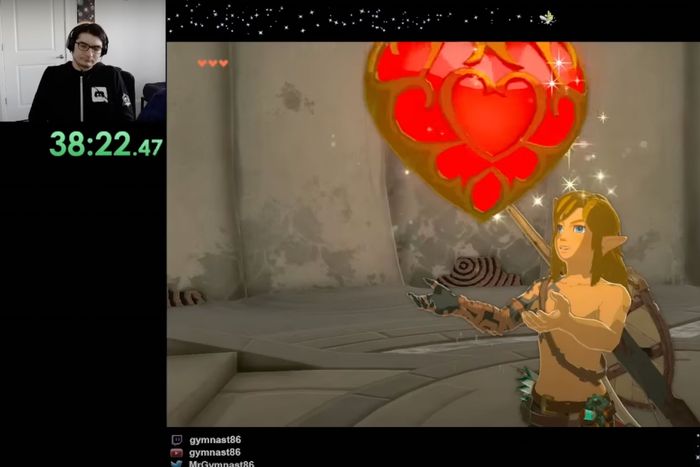
The Legend of Zelda: Tears of the Kingdom is a lot to digest. Following the game’s release less than two weeks ago, most players have barely scratched the surface of its main quest, which reportedly takes around 52 hours to beat. But most players are not like Gymnast86 — the nomme de streamme of speedrunner Carl Wernicke. Speedrunning differs a bit from title to title, but it generally involves beating a game’s mandatory objectives in order to get to the credits as fast as possible. In the case of Tears of the Kingdom, for Wernicke, that meant racing through the long opening tutorial to reach and defeat the game’s final boss, Demon King Ganondorf, without completing any of its interstitial quest lines. Wernicke posted a video on YouTube just after midnight on the morning of the game’s release on May 12, in which he set the first TOTK speedrunning record: one hour and 34 minutes.
It was all in a day’s work. “Compared to speedrunning other 3-D Zelda games,” Wernicke said during a call last week, “it’s definitely not the hardest.” Over the past decade, he’s built his digital life around beating the franchise’s games as fast as possible, streaming runs on Twitch and YouTube. When Tears’ predecessor, Breath of the Wild, was released, he was the first to run it in under an hour, notching that time within a week of its release.
So far, few major Tears exploits have been found, at least by speedrunning standards. A previous Zelda game, The Wind Waker, had a glitch that let Link swim superfast if you paused and unpaused the game 200 times. Rather than spend most of his gameplay searching for specific hacks, Wernicke focused on figuring out what he could skip, such as the laborious acquisition of certain items or finding ways to shorten the game’s tutorial. He duels Tears’ final bosses as soon as he can — fights that require mastering specific move sets without the benefit of power-ups collected during typical gameplay.
After his initial record-setting 94-minute TOTK run, Wernicke’s time was beaten by others who figured out strategies of their own. He responded by clinching a shorter 78-minute run the day before our call. Earlier this week, after our conversation, he managed a 75-minute run by skipping the paraglider, which shaved three precious minutes off his time. Wernicke and his peers are getting close to the hour mark; as of publication, the fastest time posted on Speedrun.com was from a Japanese user named Zdi, who toppled Ganondorf in 69 minutes. Tears of the Kingdom is a game that asks players to fuse objects together to create tools and weapons, inviting Link to figure out new, different ways to conquer evil. We spoke to Wernicke about his own unique approach to the game and why adding a time limit to that challenge can be part of its appeal.
Tears of the Kingdom is a very, very long game. It’s also very new, and you beat it in 94 minutes, within hours of its release practically the first day. How did you prepare yourself to get an edge on this game?
The game leaked 11 days before the North American release. In that time, people can data-mine the game to figure out a lot of information without even having to play it. And obviously I could also play the game because it had leaked. So I did a 35-hour casual playthrough before the game was released, and then I bought the game off of the Australian e-shop when it officially came out, because the game releases 18 hours earlier in Australia than it does in the United States.
So with all of that, having done the playthrough and having the time to go in and figure out all of the nitty-gritty strats that I want to do — specifically for the seven final bosses, since those are the difficult part of the run — that’s what gave me the ability to get that run and then post it basically right after the game came out. The run was actually two days old at that point. It wasn’t like I bought the game and just instantly knew everything to be able to beat it, because I’m not a magician. Though it would be really cool to be.
What’s the appeal for you in speedrunning? Why self-impose this challenge on any game, especially a game that’s been anticipated for years and years?
I’ve been speedrunning 3-D Zelda games for over ten years now. I started in 2013 with Wind Waker, and then over the years I’ve slowly just gone out and done every Zelda game, from Ocarina of Time all the way up to Tears of the Kingdom. I find it to be a very inherently interesting idea, to try to take these games, which have these defined starting and ending points, and be like, “Okay, how do we get from start to end in the quickest amount of time possible with no regard for what’s intended?” And usually that involves doing very unintended things. Pretty much every Zelda speedrun out there includes things that no person playing the game as the developers intended would ever do.
Do you have as much fun playing the game casually, without speedrunning?
I do, especially on my first time playing through the game. I thought the game was very good. I don’t think I rate it as highly as people on the internet are hyping it up —for myself, it’s probably an 8.5 or 9 out of 10. I highly enjoyed coming up with fun Ultrahand combinations to solve puzzles and whatnot. I know that there’s this whole debate about how Nintendo can get away with using inferior hardware and having all these graphical deficiencies compared to a lot of modern AAA games. But I think the game looks good enough for me to be satisfied by it, and I enjoy its art style a lot.
In one of your videos, you mentioned making Link whistle while he runs in Breath of the Wild, which causes a glitch that conserves stamina. But it appears that your first Tears speedrun has no actual glitches, yeah?
My one-hour, 34-minute time did not use any glitches whatsoever. Since then, there have been a number of glitches found, now that the wider community has their hands on the game. But that run specifically did not use any.
You’ve already done shorter runs, which use glitches. What are you working on hardest to improve right now? You mentioned the final bosses as being tough.
Well, so those fights have been slightly trivialized because of the glitches that were found. There’s one glitch we do now where we can duplicate any material that we can fuse to an arrow. So what we do is we get a single topaz. When you shoot a topaz with an arrow, it creates a giant electric field that does a lot of damage to a lot of enemies, and we just duplicate that to have ten of them. We can clear out a lot of the earlier phases of the final boss pretty quickly with that.
As of right now, there are some interesting ideas floating around for ways to skip the paraglider item, which is tricky because you have to fall down a lot to get to the final boss. You’re supposed to use the paraglider to survive those falls. But there are a number of different ways that you can get around that. For instance, if you fall a long distance and then you’re next to a wall, you can get Link to just grab the wall and slide down it without taking any damage, which is something that is used in the current run before we get the paraglider to skip some small sections.
But yeah, I mean, there’s so many new things being discovered right now that it’s sort of hard to figure out what is optimal to actually research here, because so many different ideas could go into this.
It’s a game of seemingly infinite possibilities with all the fusions and things like that. I imagine it’s kind of built for people like you — built for people who are spending a lot of their time trying to test out different creative ways of exploiting it, basically.
Zelda’s producer Eiji Aonuma went on-camera himself and was like, “I’m excited to see how you guys all try to play this game because there are so many ways to do things.” I don’t think he was imagining that speedrunners would be like, “All right, screw the paraglider, we’re just going to the final boss.” Or that people would be making Korok rotisseries.
Even in the 94-minute run that I did, even without doing any glitches, there’s still an amazing number of possibilities for how to attack all of the problems that the game throws at you. Which is also what makes it very interesting for speedrunning and very different for speedrunning compared to a lot of previous Zelda games. Before Breath of the Wild, there were very intended and set solutions for what you have to do. So if you don’t use glitches, there’s not really much freedom or leeway in how you attack some of the problems that previous games throw at you. But for this game, the sky is literally the limit.
I appreciated that you put out that video you called an “info dump” of facts on Tears of the Kingdom after your 94-minute run. You were basically sharing all these tips and laying out all this stuff. You say at the top of that video, “This will be outdated.”
It’s way outdated already.
I feel like you’re clear-eyed on this: Your time is going to be beaten. How competitive are you about that? If someone beats your time, are you going, “Oh, shit, I need to level up”?
I’m expecting somebody to beat it. This is always just what happens when a new game is released that speedrunners try to tackle.
But obviously, speedrunning is not direct competition. Most of the time when people are doing speedrun attempts, they’re not racing someone else. They’re doing their own attempts on their own stream. So usually if someone beats me, I already have a pretty good idea of how much lower my time can be compared to what my current best is. I may think, Oh, yeah, I could probably beat that because I believe that I’m good enough to get this time. Or if they get some time that’s way better than that, I’m like, Oh, wow, with my current strategies, I can’t beat that. I have to go look and see what they did, because there’s something that I’m missing here.
More From This Series
- In Video Games, There’s a Fine Line Between Difficulty and Disrespect
- The Dead Cells Toxic Sewers Level Is Hard (But It Doesn’t, Er, Stink)
- Finding the Fun in Failure



